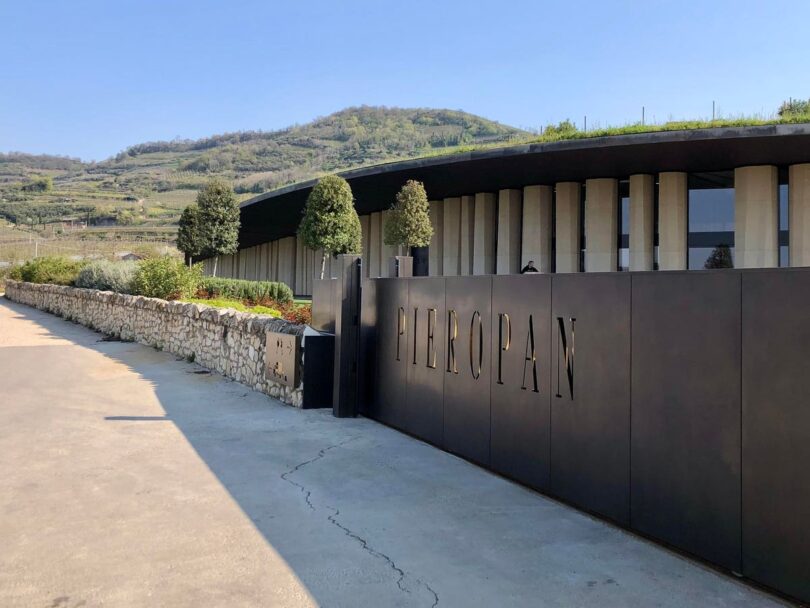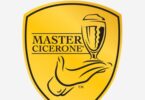Opened in 2015, the new Pieropan winery is part of a Soave hill
In the Calvarino vineyard in Soave in the Verona province of Veneto, 60 years ago winemaker Leonildo Pieropan planted a little more than two Garganega vines to every Trebbiano di Soave in 8 steep hectares now in the south of Colombara UGA, one of 33 recently official Soave zones. The first bottles released commercially and labeled vigneto Calvarino for the vineyard would be of its fruit harvested in 1971 — an unusual move then, note winery press materials, guided by advice from wine philosopher Luigi Veronelli and outside the mid-20th century focus on wine as brand or territory. A bottle of it tasted six years later in 1977, Italian wine specialist Ian D’Agata said at a presentation earlier this year, made him realize the potential of Garganega and of Soave when well taken care of —and while he placed 1979 and 1986 Calvarino within the 100 greatest Italian white wines, it was the one of rainy difficult 1992, that is “one of the best, not just white, wines of Italy.” This year, 2021, Calvarino’s 50th vintage, was released.
In Calvarino, the past is still arriving.1 Along the line of 1901 when Leonildo’s grandfather also named Leonildo bought the vineyard as the family’s first plot and the years after when his two sons launched the winery, phylloxera spread widely in the veronese countrysides. Most of the 1920s were spent in battle against that aphid’s damage and then rebuilding the vineyards felled unthinkably by them. Calvarino is a another mark of that 1971 bottle, the moment Leonildo named Pieropan’s first plot for a word passed through generations of farmers for this area “so steep and hard to work that it reminded them of a ‘little calvary,’ the trip that Jesus made before dying on the cross at Calvario hill,” Dario, Leonildo’s son and who with his brother Andrea and his mother Teserita now leads Pieropan, explained by email. Now, Calvarino is trained in both Guyot and Pergola veronese, the latter each vine with one arm grasping toward the next row perpendicular to each vertical pole for a canopy about parallel to the ground and adding more white blossom notes than cordon-spur-pruned almond notes2 to the fruit in bunches following obliquely the canopy line. In the winter, both systems are pruned firmly to eight buds, tangled wines then aged in vetrified concrete for a year or so. From early on, this wine spent plenty of time on fine lees, a lastingness understood. Vintages since 2018 have not undergone the texture-softening conversion of malo acidity into lactic. Among other things, Trebbiano di Soave’s presence is a “peariness” someone noted during a Pieropan tasting earlier this year.
Storied acidity and savory stoniness, Trebbiano di Soave would be by DNA readings and Italy’s Registry of official grapes a synonym of the celebrated Verdicchio of the Jesi and Matellica in the Marche two regions down but for that it has been cultivated here for so long it is thought to be where the Marche’s grape came from and is throughout Soave generally and unlike Verdicchio a blending grape. Unlike Pieropan’s highly regarded all-Garganega La Rocca — the family’s single-vineyard named as such by Leonildo in 1978 for “the place where the vineyard is located behind the medieval castle and on top of the hill so it looks like a rock,” Dario explains, and also just outside the small city, south calcareous clay in the Tenda UGA — in Calvarino Trebbiano di Soave is the full Soave Classico DOC maximum of 30%. In the denomination’s rules the variety is noted as “nostrano” against the Chardonnay also allowed in such quantities, and, “historically very present in these vineyards, has left always more space to the exuberance for Garganega. Only in these past years it is reproposing itself as ideal partner to draw new enological profiles for the Soave of the future combining its sapidity and vivacity with Garganega’s structure and typical density.” Grape matter differentiated in the making of this wine through taste and thick winter and thinner harvest shears, Calvarino is 60 hl/ha, 2 kg bunches per plant, controlled-climate pressing.
Colombara “makes a synthesis of several sub-areas historically singled out individually,” notes Soave Terroir, a book of descriptions and numbers of the UGAs published by the Soave consorzio in 2020. In fact, on an earlier map of various entities then all referred to as “crus” a Calvarino area appears as some Colombara section’s southern neighbor, mainly volcanic souls, with calcareous outcropping in its south. In this book, a map of Colombara’s vineyards presents almost all of them trained the local Pergola way. Soils of broken-down basalt, up to 300 meters above the Adriatic sea 55 miles east and equidistantly about half of that from windsrent lake Garda to the west and the Po river turning damp and fertile through the southern plains are some things to count in the boundaries of Soave Classico of Pieropan’s current Calvarino plantings. The weather made by and making Calvarino as vineyard of Garganega and Trebbiano di Soave, small incline of sloping landscape some steep some not, the shaking and bends of an undersea volcanic activity begun with the Tertiary period and lasting for so long that the rock ejected turned back into lava three times in this becoming land as the sea dried up to also form limestone from what previous waters had dissolved, the rocks at last breaking down “depending on the environment in which they were formed and their degree of oxidation,” reads one study, into stormy greys or yellow dirt smudging on undigested volcanic and calcareous rock, those first soils richer and deeper than the limestone ones in which agricultural practices had long been played out. “Some of the best examples include a relatively high proportion, e.g., Pieropan’s Calvarino where the variety’s steely acidity and zingy, green freshness really lifts the blend,” writes Michael Gardner of Trebbiano di Soave in Soave wines. Dario said that as a child tasting his father’s wines he had not understood Calvarino, though La Rocca had been clear to him. Calvarino “needs two or three years in bottle before tasting it for the first time.” Neither Calvarino nor La Rocca, Dario explained by email, are geographical locations.
As the vineyard grew, it too made time. In 2023 I sat waiting for wines that included 1992 and 2021 to be poured. Then, the 2021 Calvarino was quietly fruit on nose and palate but acidity and chalkiness apparent, roundness and tangerine after a while, hillside location and Garganega’s late flowering did not include the possibility of frost that hit the flatter places, but hill and spring meant cooler temperates, then hot and dry and smaller and fewer berries, rain and hail, dry windy late summer and mid-September harvest of the Trebbiano di Soave and in October (the “most suitable vineyards” are harvested last, notes Pieropan’s website) with cold nights and 25% less fruit than the 2020, in this second year of the pandemic. This future was remembered in 1992 when instead mild winter and early budding formed larger bunches onto which fell abundant June rain and high temperatures all summer day and night until a thunderstorm on 30 August lowered temperatures to drive up sugar levels, rainy September harvest, low acidity and the rot it and the rain conspired with and so grape selection in the vineyards, “polyphenol content,” such smokiness on palate, lemon, lime, acidity, lovely and integrated and standing out anyway, especially amaragnolo on finish, “higher than the previous year, acidity and sugars slightly below average,” into this glass continuously made determinate, that is of where site, Leonildo and his descendants’ decisions about it, grapes chosen enough throughout years’ differences again and again by pruning and when picked, weathering like rocks, thinking of this something locally into site and grapes and Soave, the water that winter brought, the rain in terrible timing, hoped-for sun and wind, the measurements of pH 3.20 and 6.15 g/l total acidity for 2021 and 5,94 g/l and pH 3,22 “more or less the same” for 1992 and my enjoyment of it marks of the wine on me, my notebooks, someone else’s pH meter, all an uneasiness of volcanic place.
Leonildo passed away in 2018, ten years after co-founding the nationwide network of small producers called Fivi and while the first drops of a new bottling were landing. Released in 2022, Calvarino 5 is a multi-vintage of that vineyard and two Pieropan cellars, a blend of five consecutive years also beginning in 2008 then aged for at least 10 years in cement and in bottle, 7,000 which will not be repeated, since 2020. As unerasable, sedimenting effects of the past,3 Calvarino is the first wine of Pieropan’s new Vini dell’Anima line, whose upcoming bottles will pick up being vintage again. Dario says he has tasted that Calvarino 1992 — whose label still noted the name as vigneto — over years, and it always tastes like this, as it did 10 and 20 years ago. Growing too, in a new, large, Peiorpan winery opened in 2015 in the side of a hill once also made of mines from the world wars, a new part of the Pieropan business is holding vintages for future collections.








